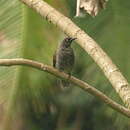Biology
(
英語
)
由Arkive提供
The shy and inconspicuous nature of the Rarotonga starling and the ruggedness of its montane habitat contribute to the lack of information on this species. It has been seen either alone or in pairs, searching for nectar, fruit and insects in the forest canopy (2). The favoured food of the Rarotonga starling is the nectar of the endemic Rarotonga fitchia (Fitchia speciosa) which as a large, spiky orange flower with copious amounts of nectar from April to June. So important is this mutualistic relationship that the flower of the fitchia is always bent back towards the branch to enable easy access as the starling stands on the branch (4). Historically, it was reported that the nectar from the bright red flowers of the coral tree, introduced by the Polynesians, was also one of the starling's preferred food, but there are much fewer coral trees on the island today (5).
The Rarotonga starling is a territorial bird, which returns to the same nest to breed year after year. Eggs are laid between August and December, generally in clutches of more than one (2). The territorial behaviour of the Rarotonga starling led to its reputation as the fugitive's friend, as the bird would call when other people entered its territory thus warning the fugitive of danger. "'I'oi karanga", the starling warns, is a famous traditional saying (4).
Conservation
(
英語
)
由Arkive提供
The lack of data on numbers and distribution of the Rarotonga starling means that a decline could go undetected. Therefore, a survey to determine its status and continued monitoring is strongly recommended (2) (7).
Description
(
英語
)
由Arkive提供
This little known bird belongs to a family that is known for their ability to imitate the sounds they hear (3). The Rarotonga starling has dark brownish-grey plumage with a conspicuous pale area under the tail, and yellow eyes. The legs, feet and bill are black (4). The local name of this bird, 'I'oi, comes from its distinctive whistling ee-oi, ee-oi call (5).
Habitat
(
英語
)
由Arkive提供
The Rarotonga starling inhabits undisturbed montane forest and fringing disturbed forest, in the interior of the island, generally between elevations of 150 and 600 meters, although sometimes observed as low as 30 meters (2).
Range
(
英語
)
由Arkive提供
Occurs only on Rarotonga, one of the Cook Islands, in the South Pacific Ocean (2).
Status
(
英語
)
由Arkive提供
Classified as Vulnerable (VU) on the IUCN Red List 2006 (1).
Threats
(
英語
)
由Arkive提供
Although the Rarotonga starling has been very inadequately surveyed, numbers are thought to be stable at present, based on the presumed lack of serious threats to it in the inland mountains of the island (4). On the lower slopes of Rarotonga, little native vegetation remains, and this, in combination with competition with the introduced common myna, is thought to be the reason why the Rarontonga starling is no longer found in coastal areas of the island (6). Common mynas harass any native landbirds that try to nest on the lowland horticultural zone (4). Luckily, large areas of undisturbed montane rainforest remain on the upper slopes of Rarotonga in which the starling can persist (2). Any further introductions, particularly of exotic avian diseases, could have a potentially devastating impact (2). The vulnerability of this species to such threats is illustrated by the extinction of at least three other Aplonis species from Pacific islands in the last century (1).

